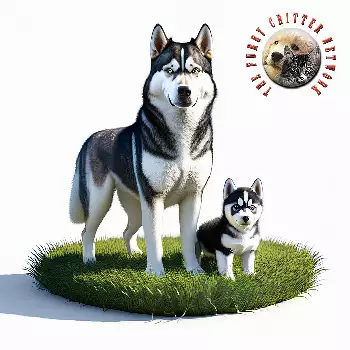Boxsky
Hybrid Breed Description
The Boxsky is a cross between the Boxer and the Siberian Husky. Because each hybrid inherits a unique combination of traits from both parents, we recommend thoroughly researching both breeds before choosing a Boxsky. Pay special attention to temperament, health issues, and care requirements, as your dog may express characteristics from either parent breed.
Boxer

The Boxer presents as a medium to large dog with males typically reaching twenty-three to twenty-five inches at the shoulder and weighing sixty to eighty pounds, while females stand twenty-one to twenty-three inches tall and weigh fifty to sixty-five pounds. This breed displays a distinctively square build with powerful, well-developed musculature beneath taut skin. The head is perhaps the most recognizable feature, characterized by its broad skull and blunt muzzle with an undershot jaw, creating the breed's signature expression. Dark, intelligent eyes convey alertness and curiosity, while the ears traditionally fold over naturally, though some have historically been cropped to stand erect. The Boxer's body construction reflects its athletic heritage, featuring a deep, broad chest that extends to the elbows, strong shoulders, and a relatively short, powerful back. The breed moves with remarkable grace and agility despite its muscular frame, exhibiting a smooth, ground-covering stride. Legs are straight and well-boned without being heavy, with compact feet and arched toes. The tail, when left natural, curves slightly at the end and is carried with alertness. The coat is short, smooth, and glossy, lying tight to the body and requiring minimal grooming. Colors include fawn, which ranges from light tan to dark reddish-brown or mahogany, and brindle, featuring black stripes on a fawn background. White markings commonly appear on the face, chest, legs, and feet, creating the distinctive "flashy" appearance, though these markings should not exceed one-third of the overall coat. The breed's characteristic black mask on the face adds to its noble and distinctive appearance.
Key Characteristics
Boxers exhibit a remarkably playful and exuberant temperament that remains puppy-like well into adulthood, often not reaching full maturity until around three years of age. These dogs are renowned for their boundless energy and enthusiasm, displaying characteristic behaviors such as the "kidney bean" dance where they curve their body into a semicircle and spin with joy, and vigorous butt wiggling when excited. Their expressive faces and tendency to use their front paws in play earned them their name, as they appear to box with their paws. Despite this playful nature, Boxers are remarkably intelligent and sensitive dogs who read human emotions exceptionally well and can be trained for various working roles. Family bonds are paramount to the Boxer temperament, as these dogs form deep attachments to their human pack and demonstrate fierce loyalty. They are particularly gentle and patient with children, often acting as protective guardians while maintaining a playful spirit. Boxers thrive on human companionship and do not fare well when left alone for extended periods, which can lead to destructive behaviors born of boredom or separation anxiety. While generally friendly toward other dogs when properly socialized, they can be reserved or territorial with unfamiliar dogs. Their natural vigilance makes them excellent watchdogs who will alert their family to anything unusual, though they are not typically aggressive without cause. Training a Boxer requires patience, consistency, and positive reinforcement methods, as harsh corrections can backfire with this sensitive breed. Their intelligence means they learn quickly but can also become bored with repetitive exercises. Boxers need substantial daily exercise to channel their high energy appropriately, requiring at least an hour of vigorous activity. Without adequate physical and mental stimulation, these athletic dogs may develop unwanted behaviors such as jumping, chewing, or excessive barking.
Boxers face several significant health concerns that prospective owners should understand. The most serious is cardiomyopathy, particularly Arrhythmogenic Right Ventricular Cardiomyopathy, which affects nearly forty percent of the breed. This genetic condition causes irregular heartbeat and can lead to sudden death, typically appearing between three and seven years of age. Dilated cardiomyopathy is another cardiac concern where the heart muscle becomes thin and pumps weakly. Regular cardiac screening by a veterinary cardiologist is essential for early detection and management. Cancer also ranks among the leading causes of death in Boxers, with mast cell tumors, lymphoma, brain tumors, and hemangiosarcoma occurring more frequently than in many other breeds. The breed's brachycephalic skull structure creates breathing challenges and heat sensitivity. Their shortened airways make panting less effective for cooling, so Boxers can easily overheat and should be carefully monitored in warm weather. This anatomical feature also increases their risk of gastric dilatation-volvulus, a life-threatening emergency where the stomach fills with gas and rotates. Feeding smaller, more frequent meals and limiting exercise around mealtimes can help reduce this risk. Hip dysplasia, though less common in Boxers than some breeds, does occur and can lead to arthritis and mobility issues. Other health considerations include hypothyroidism, which affects metabolism and can cause weight gain, lethargy, and coat problems. Degenerative myelopathy, a progressive spinal cord disease similar to ALS in humans, eventually leads to paralysis of the hind legs. Various eye conditions including corneal ulcers occur frequently in Boxers. The breed typically lives ten to twelve years, though many owners lose their dogs to cancer at younger ages. Responsible breeders screen for cardiac disease, hip dysplasia, and thyroid function to help produce healthier puppies.
Siberian Husky

The Siberian Husky is a medium-sized working dog built for endurance and speed in harsh Arctic conditions. Males typically stand twenty-one to twenty-three and a half inches at the withers and weigh forty-five to sixty pounds, while females measure twenty to twenty-two inches tall and weigh thirty-five to fifty pounds. Despite being smaller than many assume, these dogs are remarkably powerful and athletic. The breed features erect triangular ears that sit high on the head, contributing to an alert and wolf-like expression. Eyes are one of the Husky's most striking features, appearing in shades of brown, blue, or sometimes one of each color, set at a slight oblique angle that enhances their keen, friendly expression. The Siberian Husky's body is compact and well-proportioned, slightly longer than tall, with a level topline and well-developed musculature that appears smooth rather than bulky. The chest is deep but not excessively broad, and the ribs are well-sprung. Shoulders are well laid back, and legs are straight and parallel with moderate bone that is substantial but never heavy. Feet are oval and compact with well-furred toes and thick pads adapted for traveling over snow and ice. The characteristic bushy tail is fox-brush shaped and carried in a graceful sickle curve over the back when the dog is alert. The double coat is the breed's protection against extreme cold, consisting of a soft, dense undercoat and a medium-length outer coat of straight guard hairs that lies relatively smooth. The coat creates a well-furred appearance without obscuring the dog's clean lines. Colors range widely from pure white to solid black and everything in between, including various shades of gray, red, and agouti. Most dogs display white markings particularly on the face, chest, and legs, often creating distinctive masks, caps, or spectacle patterns on the head that are unique to each individual.
Key Characteristics
Siberian Huskies possess a friendly, gentle temperament combined with notable independence that stems from their heritage as working sled dogs who had to make decisions to keep their mushers safe. This independent thinking can manifest as stubbornness, as Huskies do not have the same eagerness to please as many breeds and must be convinced that obeying commands serves their own interests. They are highly intelligent dogs who learn quickly but may choose not to comply, requiring patient, consistent training with positive reinforcement from an early age. Their problem-solving abilities, while impressive, can lead to escape artist behaviors as they figure out how to open gates, jump fences, or dig under barriers in pursuit of adventure. Socially, Huskies are remarkably friendly toward people, including strangers and children, making them poor guard dogs but excellent family companions. They genuinely enjoy human company and can become destructive when left alone for extended periods due to their pack-oriented nature. Most Huskies get along well with other dogs, especially when raised together, though their strong prey drive means they may chase cats, small pets, and livestock. This instinct requires secure fencing and leash management during walks. Rather than barking, Huskies are famous for howling and making various vocalizations that sound remarkably like talking, often joining in with sirens or attempting to communicate with their owners through these distinctive sounds. The breed's energy level is extremely high, reflecting their breeding for pulling sleds over vast distances. Huskies require substantial daily exercise, ideally one to two hours of vigorous activity such as running, hiking, or participating in dog sports like skijoring or sledding. Without adequate physical and mental stimulation, they will find ways to entertain themselves through digging, chewing, or other destructive behaviors. They are natural diggers who create cool spots to lie in during warm weather, which can wreak havoc on yards and gardens.
Siberian Huskies are prone to several inherited eye conditions that can significantly impact vision. Progressive Retinal Atrophy causes gradual degeneration of the retina, typically beginning with night blindness and eventually progressing to complete blindness, often within one to two years of symptom onset. This sex-linked condition appears more frequently in male Huskies. Cataracts can develop in young Huskies, sometimes as early as three months of age, caused by genetic factors rather than aging. The cloudy appearance results from protein buildup in the lens that blocks light. Corneal dystrophy affects multiple layers of the cornea, causing opacity and potential ulceration. Glaucoma from increased eye pressure can lead to blindness, and uveodermatologic syndrome affects both eyes and skin, potentially causing blindness in severe cases. Hip dysplasia occurs in Siberian Huskies despite being less common than in many breeds, causing the hip joint to develop abnormally and leading to arthritis and mobility problems. Hypothyroidism results from underproduction of thyroid hormone, causing weight gain despite normal eating, lethargy, hair loss, and skin problems. This condition requires lifelong hormone replacement medication. Degenerative myelopathy is a progressive neurological disease affecting the spinal cord, similar to ALS in humans, causing progressive weakness and eventual paralysis of the hind legs. While no cure exists, physical therapy, exercise, and supplements can help manage symptoms. The breed also faces risks from several Husky-specific genetic conditions. Zinc-responsive dermatosis causes hair loss on feet, elbows, and facial areas when dogs cannot properly absorb zinc. Follicular dysplasia leads to abnormal hair growth and patchy hair loss beginning around three to four months of age. Some Huskies carry genes for Shaking Puppy Syndrome Type 1, which causes tremors and mobility issues in young puppies, often resulting in early death. Siberian Husky Polyneuropathy Type 1 causes progressive gait abnormalities and muscle weakness. The breed typically lives twelve to fifteen years, with cancer becoming more common in senior dogs.
Important to Remember
Each hybrid dog is unique and may inherit any combination of traits from either parent breed. The information above represents the characteristics of the purebred parent breeds. Your Boxsky may favor one parent over the other or display a blend of both. We strongly encourage you to read the complete breed profiles for both the Boxer and Siberian Husky to fully understand the range of possible temperaments, health concerns, and care requirements.